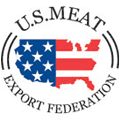 The time-tested relationship between the United States’ Foreign Agricultural Service (FAS) and the U.S. Meat Export Federation (USMEF) has been built on collaboration in a shared mission of expanding agriculture exports, and the “bright spot” that FAS sees in the form of increased red meat exports and jobs creation is an important measurement of success, according to FAS Administrator Suzanne Heinen.
The time-tested relationship between the United States’ Foreign Agricultural Service (FAS) and the U.S. Meat Export Federation (USMEF) has been built on collaboration in a shared mission of expanding agriculture exports, and the “bright spot” that FAS sees in the form of increased red meat exports and jobs creation is an important measurement of success, according to FAS Administrator Suzanne Heinen.
“FAS and USMEF have a strong partnership, and a partnership that works,” said Heinen in her address to USMEF’s membership recently at the organization’s Board of Directors meeting in New Orleans. “Our success is measured by the level of growth of exports and the barriers (to trade) eliminated.”

|
FAS Administrator |
Heinen noted that a 65 percent increase in red meat exports over the past five years is not only an excellent return on investment for the USDA’s Market Access Program (MAP) and Foreign Market Development (FMD) program funds provided through FAS to USMEF, but a “positive sign for the grain industry as well, since what we export in meat is just grain turned into another product. It’s good for the American economy since we’re adding value and holding jobs here at home.”
Beyond USMEF’s role in the marketing and promotion of U.S. beef, pork and lamb, Heinen noted that USMEF and the other cooperators in the MAP and FMD programs provide valuable on-the-ground intelligence in markets around the world.
“We really rely on USMEF for policy guidance on a daily basis,” Heinen said. “We need critical thinking when we negotiate with these governments…we need the expertise of you in the industry.”
The FAS administrator cited the recent global reaction - an overall positive one - to the April finding of the United States’ fourth BSE (bovine spongiform encephalopathy) case – an “atypical” case that is unrelated to the consumption of cattle feed.
“A great example of our (FAS and USMEF’s) partnership at work is the fact that only two markets of nearly 100 where we export have taken action (to restrict U.S. beef imports),” said Heinen. “That measured response is a direct result of our joint efforts to provide education and reassure our trading partners that U.S. beef is safe.”
She also cited USMEF’s work with FAS to provide information to the international Codex Alimentarius Commission to get scientific support for maximum residue levels (MRLs) for safe and effective agriculture enhancing products that support efficient and sustainable growth of U.S. agricultural products.
In tight economic times where all government-funded programs are being scrutinized for their economic impact, Heinen noted that USMEF’s track record of providing a rationale for its program activities, documenting them and evaluating them gives “us the results we can take to Congress to prove to them that the money they give us is moving the needle on exports and moving the needle on jobs.”
"When you get into overseas markets, beef is not competing against pork or pork against chicken,” she said. “We’re competing against Brazil, the EU and other countries.”
Heinen noted that USDA’s market development programs have a long history of helping farmers, ranchers, and businesses of all sizes build and maintain commercial markets for U.S. food and agricultural products around the world, and that those programs “show results,” adding that independent studies have documented the return on investment for MAP and FMD. Those studies show that for every dollar that government and industry invest in market development programs and activities, agricultural exports increase by $35.



